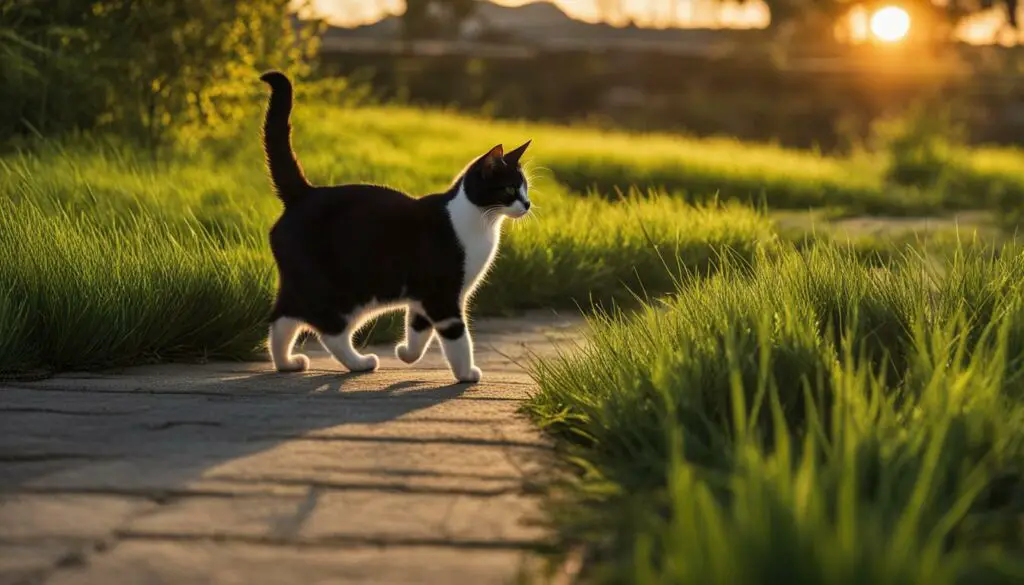Cats are known for their adorable and sometimes puzzling behaviors. One of these behaviors is when cats run and hop sideways like a furry crab. In this article, we will explore the reasons behind cats’ sideways walking and whether it should be a cause for concern. We will gather information from multiple sources to provide a comprehensive understanding of this behavior.
Key Takeaways:
- Cats may walk sideways when they feel threatened or afraid, using it as a defensive posture.
- Sideways walking can also be a playful behavior, expressing a cat’s energy and need for interaction.
- It is normal for cats to have bursts of high energy, but excessive sideways walking may indicate underlying issues.
- Male cats, especially during mating season, are more prone to engage in sideways walking as a defensive posture.
- Sideways walking can also be an attention-seeking behavior, indicating boredom or a desire for interaction.
Cats Feel Threatened When They Walk Sideways
When it comes to cat behavior, walking sideways can be a sign of feeling threatened or afraid. This defensive posture is often accompanied by other signs of aggression, such as tail puffing, raised fur, and vocalization. Cats may exhibit sideways walking when they perceive a threat from other animals, unfamiliar scents, or even inanimate objects.
Understanding the signs of aggression and territorial behavior can help prevent conflicts and keep the peace in multi-cat households. It is essential to provide a safe and stress-free environment for your cats, ensuring they have their own space and resources. Neutering male cats can also help reduce territorial behavior and aggression, making for a more harmonious living environment.
Here are some signs of cat aggression to look out for:
- Puffing up the tail and fur
- Showing fangs and claws
- Arching the back
- Growling, hissing, or meowing aggressively
| Signs of Cat Aggression | Possible Causes |
|---|---|
| Puffing up the tail and fur | Feeling threatened or afraid |
| Showing fangs and claws | Preparing to attack or defend |
| Arching the back | Trying to appear larger and more intimidating |
| Growling, hissing, or meowing aggressively | Warning potential adversaries to stay away |
It is important to approach a cat exhibiting signs of aggression with caution, as they may act out defensively if they feel cornered. Providing them with a safe space to retreat to and avoiding any triggers can help de-escalate the situation.
Remember, if your cat displays aggressive behavior consistently or excessively, it’s always a good idea to consult with a veterinarian or a certified animal behaviorist to address any underlying issues and ensure the well-being of both your cat and your household.
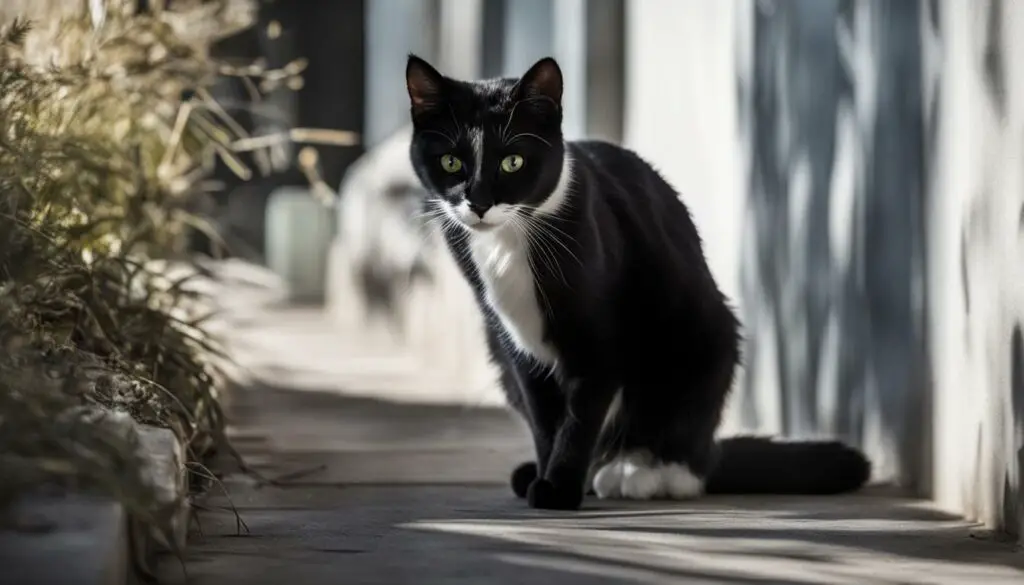
Cats Walk Sideways When They Want to Play
Cats are known for their playful nature, and walking sideways can be an indication that they are in a playful mood. When cats want to play, they may engage in various energetic movements, including running, jumping, and yes, even walking sideways. This sideways activity is an expression of their energy and a way to burn off excess energy. It’s their way of letting off some steam and having fun.
Interactive play sessions are incredibly important for cats. Not only do these play sessions provide mental and physical stimulation, but they also help fulfill their natural instincts and provide an outlet for their energy. Engaging in interactive play with your cat using toys, such as feather wands or laser pointers, can keep them entertained and prevent boredom.
“Playtime is essential for cats, as it promotes exercise, mental stimulation, and a healthy bond between you and your feline friend. Make sure to dedicate regular play sessions and provide an environment that encourages movement and exploration.”
When playing with your cat, it’s essential to remember a few things. Firstly, always use toys that are safe for cats, avoiding small objects that could be a choking hazard. Secondly, be sure to vary the play sessions, offering a mix of interactive play and independent play with puzzle toys or treat dispensers. Finally, observe your cat’s energy levels and adjust the play sessions accordingly. Some cats are more active during certain times of the day, so try to match their playtime to their natural energy peaks.
Benefits of Interactive Play with Cats
- Physical exercise
- Mental stimulation
- Bonding time with your cat
- Stress and anxiety relief
- Prevention of destructive behaviors
| Toy | Description | Benefits |
|---|---|---|
| Feather wand | A long wand with feathers attached to the end. It mimics the movements of birds and stimulates your cat’s hunting instincts. | Encourages physical activity, provides mental stimulation, and helps strengthen the bond between you and your cat. |
| Laser pointer | A handheld device that emits a small laser dot. Cats love chasing the elusive red dot, providing a great source of exercise and mental stimulation. | Offers high-intensity exercise, engages your cat’s natural hunting instincts, and provides mental stimulation. |
| Treat dispenser puzzle toy | A toy that dispenses treats or kibble when your cat interacts with it. It requires problem-solving skills and keeps your cat engaged and entertained. | Provides mental stimulation, prevents boredom, and encourages independent play. |
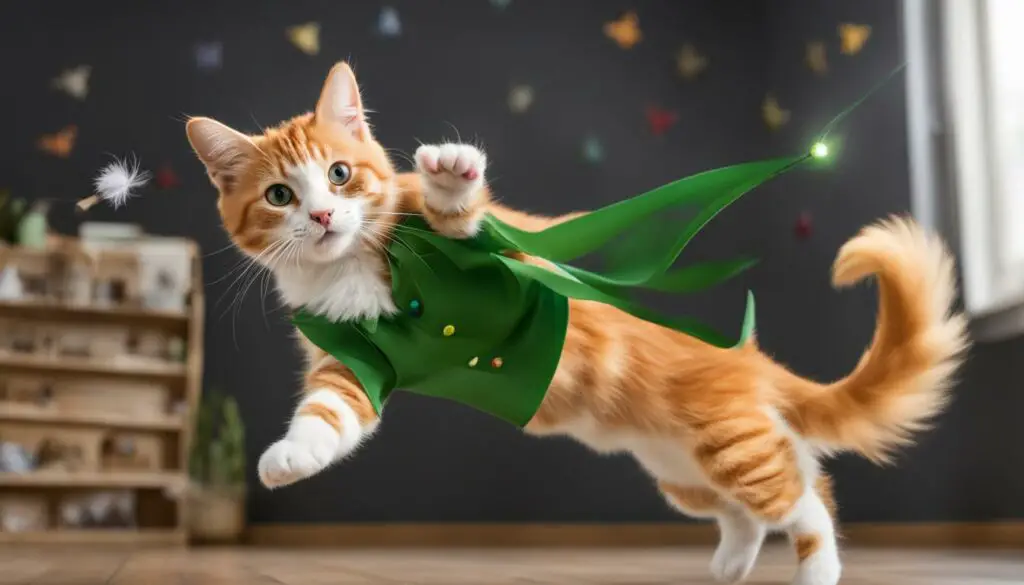
Playing with your cat is not only enjoyable for both of you but also beneficial for their overall well-being. By engaging in interactive play sessions and providing a variety of toys, you can fulfill their playtime needs, keep them entertained, and strengthen the bond you share.
Sideways Walking is an Expression of Feline Energy
Cats are known for their playful nature and high energy levels. One manifestation of this energy is sideways walking, often referred to as “cat zoomies.” During these episodes, cats may engage in quick bursts of sideways movement, running, jumping, and vocalizing. It is a natural behavior that allows cats to release their pent-up energy and express their exuberance.
Hyperactive cats are more prone to experiencing frequent episodes of sideways walking. These cats have an abundance of energy that needs to be expended. Providing them with opportunities for exercise and mental stimulation can help redirect their energy in a positive way. Interactive play sessions, puzzle toys, and scratching posts can all help engage their minds and keep them physically active.
To better understand why cats engage in sideways walking, it is important to consider their overall behavior and living environment. Cats that lack proper stimulation may exhibit more frequent and intense episodes of sideways walking. Ensuring that your cat has an enriching environment with plenty of toys, scratching surfaces, and vertical spaces to explore can help satisfy their energy needs and reduce the likelihood of excessive zoomies.
Cat Exercise: A Key to a Happy and Healthy Feline
In addition to sideways walking, regular exercise is essential for a cat’s overall well-being. It helps maintain a healthy weight, prevents obesity-related health issues, and promotes good mental health. Providing your cat with opportunities for physical activity can be as simple as setting aside dedicated playtime each day. Use toys that encourage them to chase, jump, and pounce, mimicking natural hunting behaviors. Creating a consistent exercise routine will not only benefit your cat’s energy levels but also strengthen the bond between you and your furry friend.
| Benefits of Exercise for Cats | Ways to Encourage Exercise |
|---|---|
| 1. Maintains a healthy weight | 1. Set aside dedicated playtime |
| 2. Reduces the risk of obesity-related health issues | 2. Use interactive toys that encourage physical activity |
| 3. Promotes mental stimulation and prevents boredom | 3. Provide scratching posts, climbing trees, and tunnels |
| 4. Enhances the bond between you and your cat | 4. Rotate toys to keep them engaged |
Remember, every cat is unique, and their exercise needs may vary. Some cats may prefer short, intense play sessions, while others may enjoy longer, more leisurely activities. It’s important to observe your cat’s preferences and adjust your exercise routine accordingly. By providing them with physical and mental stimulation through regular exercise, you can help keep their energy levels balanced and ensure a happy and healthy feline companion.
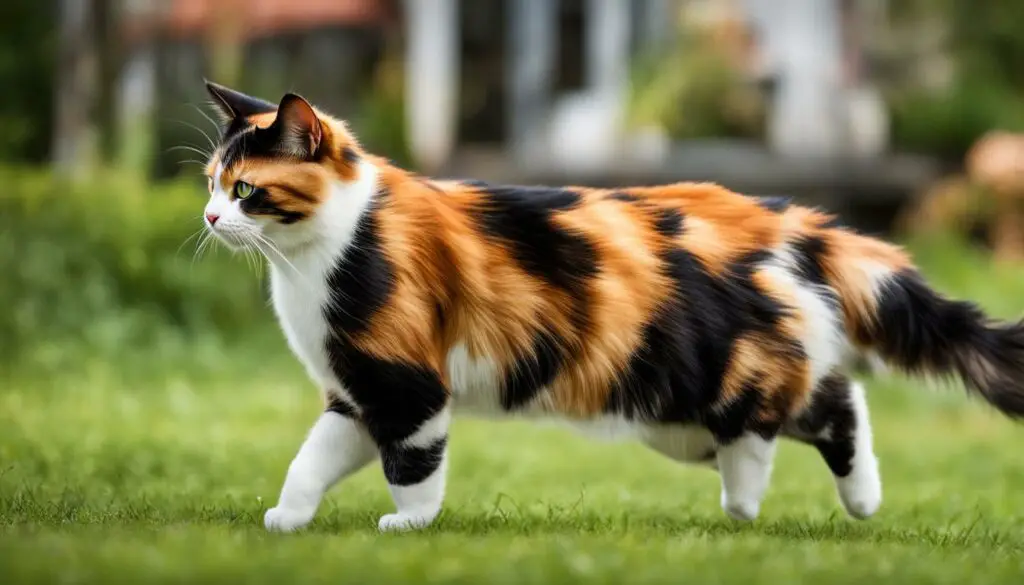
Sideways Walking as a Defensive Posture
When it comes to cat behavior, sideways walking can sometimes be a sign of a cat adopting a defensive posture. This behavior is often seen when cats feel threatened or spooked, and it serves as a way for them to quickly flee or attack if necessary. Sideways walking allows cats to be agile and ready to face any potential threats that come their way.
Cats have a natural instinct to be on alert and protect themselves in the wild, which can make them prone to feeling defensive in certain situations. This behavior is especially common in male cats during the mating season when their territorial behavior is heightened. Neutering male cats can help prevent unnecessary conflicts and reduce aggressive behavior, minimizing the need for defensive postures like sideways walking.
Table: Instances Where Cats May Exhibit Sideways Walking as a Defensive Posture
| Situation | Cat’s Behavior |
|---|---|
| Encounter with a potential threat | Sideways walking as a defensive posture |
| Feeling intimidated by other animals | Sideways walking accompanied by other signs of aggression |
| Increased territorial behavior in male cats | Frequent sideways walking to assert dominance |
Understanding when and why cats adopt a defensive posture like sideways walking can help owners prevent conflicts and provide a safe environment for their feline companions. By recognizing the signs of a threat or potential aggression, owners can take appropriate steps to ensure their cat’s well-being and promote a peaceful coexistence.
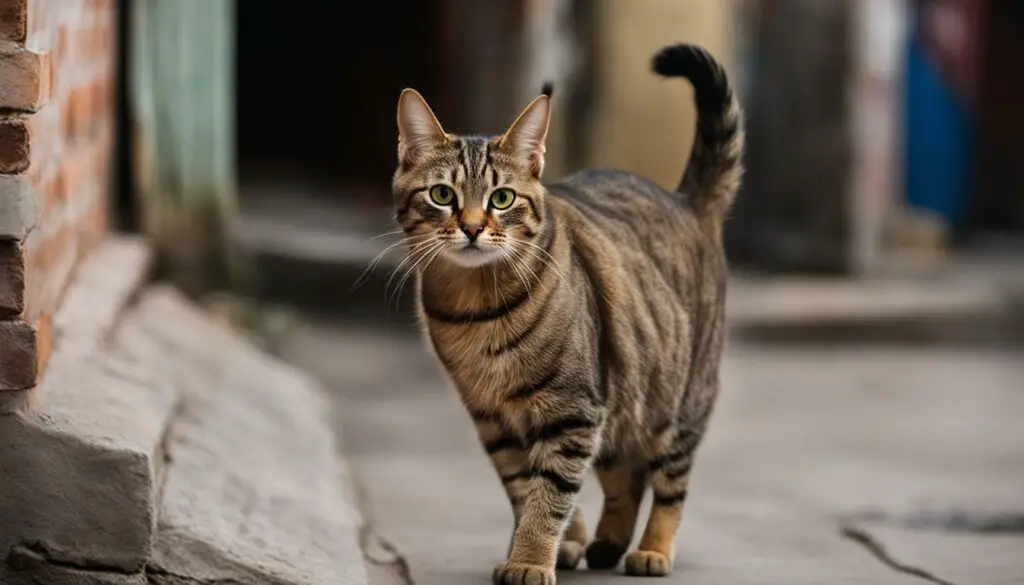
Cats Walk Sideways to Seek Attention
Have you ever wondered why your cat suddenly starts walking sideways, almost like a sideways hop? It turns out that cats use this intriguing behavior as a way to seek attention from their owners. When cats feel neglected or bored, they may engage in attention-seeking behaviors to capture your focus and stimulate interaction.
According to experts, cats may resort to sideways walking when they crave stimulation and playtime. This behavior is their way of saying, “Hey, pay attention to me!” So, if you see your cat trotting sideways towards you, it’s time to put down that smartphone, set aside your work, and give them some quality time.
Spending dedicated playtime with your feline friend is crucial to keep their boredom at bay and prevent destructive behaviors. Providing interactive toys, engaging in games that mimic hunting, and offering scratching posts can keep your cat entertained and mentally stimulated. By investing time and effort into your cat’s play needs, you’ll foster a stronger bond and create a happier, healthier environment for both of you.
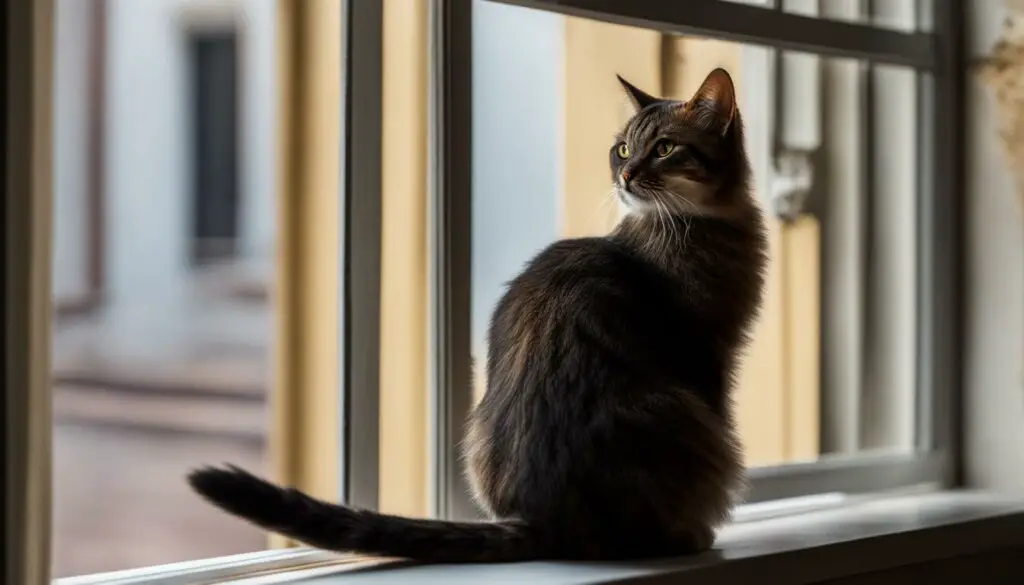
Table: Ways to Keep Your Cat Engaged and Prevent Destructive Behavior
| Activity | Description |
|---|---|
| Interactive Play Sessions | Set aside dedicated time each day to engage your cat in play sessions using interactive toys such as feather wands or laser pointers. This will help fulfill their natural hunting instincts and provide mental stimulation. |
| Environmental Enrichment | Create an enriching environment for your cat by adding scratching posts, climbing trees, and puzzle toys. This will provide them with outlets for exploration, exercise, and mental stimulation. |
| Rotate Toys | Keep your cat’s toys interesting by rotating them periodically. This will prevent boredom and prolong their interest in playtime. |
| Interactive Feeding | Use interactive feeding toys, such as puzzle feeders or treat balls, to make mealtime more engaging for your cat. This will stimulate their natural foraging instincts and provide mental stimulation. |
By dedicating time and attention to your cat’s needs, you can ensure they lead a happy and fulfilling life. Remember, cats communicate through their behaviors, and sideways walking is their way of saying, “I want to play and interact with you!” So, seize the opportunity to strengthen your bond and create memorable moments with your feline companion.
Sideways Walking in Kittens
Just like human babies, kittens go through various developmental stages, and their behavior can be quite different from adult cats. One common behavior seen in kittens is sideways walking. This adorable and playful movement is a natural part of their motor skill development and play behavior.
Kittens have boundless energy levels and are constantly exploring their environment. Sideways walking is often a result of their high energy and curiosity. It allows them to navigate obstacles and engage in playful movements. So, if you see your little furball happily hopping and running sideways, there’s no need to worry!
| Age | Behavior |
|---|---|
| 2-4 weeks | Exploring their surroundings, wobbling movements |
| 4-8 weeks | Playful movements, sideways walking, pouncing on toys |
| 8-12 weeks | Increased coordination, running, jumping, climbing |
It’s important to provide a safe and stimulating environment for kittens to support their development. Offer plenty of age-appropriate toys and interactive play sessions to channel their energy and keep them engaged. Creating a kitten-friendly space with scratching posts, climbing structures, and hiding spots will also help satisfy their natural instincts.
In conclusion, sideways walking in kittens is a completely normal behavior that should be encouraged and enjoyed. It’s a playful expression of their energy and curiosity. As they grow and develop, you’ll see their movements become more coordinated and graceful. So, embrace the cuteness and cherish these precious moments with your little sideways-walking bundle of joy!
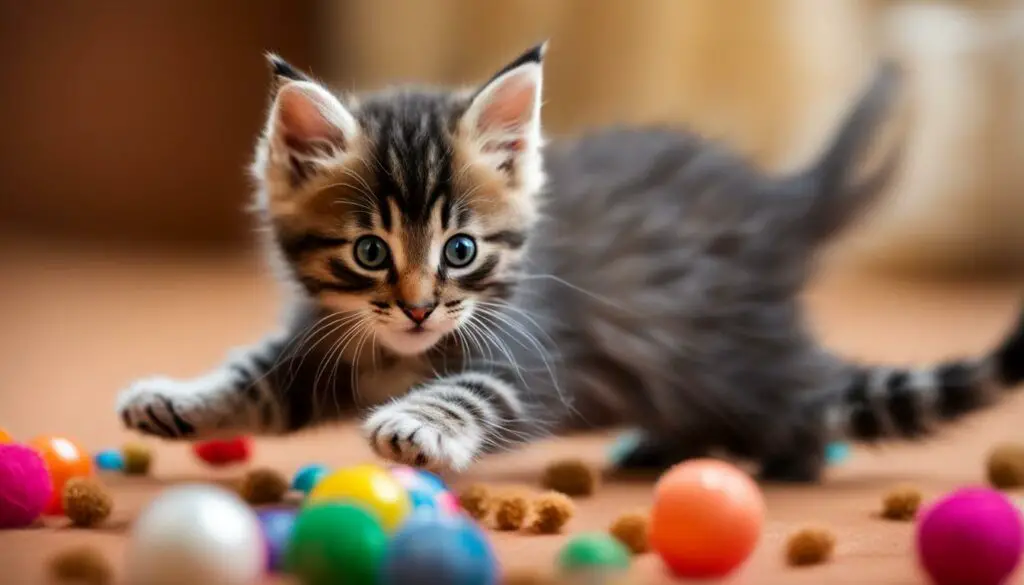
Cat Body Language: Decoding Tail Puffing and Sideways Walking
Cats have a unique way of communicating their emotions, and their body language provides valuable insights into their mindset. One intriguing behavior that cats exhibit is sideways walking, often accompanied by tail puffing. This combination of movements is a clear indication of defensive behavior in cats, signaling their readiness to protect themselves if necessary.
When a cat walks sideways, it is adopting a defensive posture to make itself appear larger and more intimidating. This sideways movement, coupled with tail puffing, is a clear warning sign to potential threats, advising them to keep their distance. It is important to understand that this behavior is a natural response to fear or aggression and should be respected.
According to feline behavior experts, sideways walking and tail puffing are often seen during territorial disputes or confrontations with other animals. Cats may also exhibit this behavior when they feel threatened by unfamiliar people or objects in their environment. By recognizing these signs of defensive behavior, we can better understand our furry friends and provide them with the support they need to feel safe and secure.
Quotes:
“Sideways walking and tail puffing are clear indications that a cat is feeling threatened or defensive. It is important to respect their boundaries and provide them with a calm and secure environment.” – Dr. Sarah Thompson, Feline Behavior Specialist
Table: Decoding Cat Body Language
| Body Language | Meaning |
|---|---|
| Sideways Walking | Defensive behavior, feeling threatened |
| Tail Puffing | Display of aggression or fear |
| Arched Back | Defensive posture, appearing larger |
Understanding cat body language is crucial for building a strong bond with our feline companions. By paying attention to their movements and behaviors, we can provide them with the care and support they need. Remember, each cat is unique, so it’s important to observe and learn their individual communication signals to ensure a happy and harmonious relationship.
The Significance of Arched Backs in Sideways Walking
Sideways walking in cats often involves the cat arching its back, which is a significant aspect of this behavior. When a cat walks sideways with an arched back, it is adopting a defensive posture. The arched back serves multiple purposes, including making the cat appear larger and more intimidating to potential threats. It is a natural instinct for cats to arch their backs when they feel threatened or need to defend themselves.
When a cat walks sideways with an arched back, it is communicating its readiness to flee or attack if necessary. The arched back, coupled with sideways walking, allows the cat to quickly evade its opponent or strike back in defense.
This defensive posture is especially common in male cats during the mating season when territorial behavior is heightened. The arched back and sideways walking serve as a warning to other animals to stay away and can help prevent unnecessary conflicts. Neutering male cats can help reduce territorial behavior and minimize the need for defensive posturing.
It is important to note that sideways walking with an arched back can also be a normal play behavior in cats. During playtime, cats may adopt this posture as a way to display their energy and enthusiasm. However, it is crucial to distinguish between play behavior and defensive behavior, especially when observing other signs of aggression or fear.
| Indications of Defensive Posture in Sideways Walking | Signs of Playful Behavior in Sideways Walking |
|---|---|
|
|
Understanding the significance of arched backs in sideways walking allows us to interpret a cat’s body language more accurately. By recognizing whether the behavior is defensive or playful, we can respond appropriately and ensure the cat feels safe and understood.
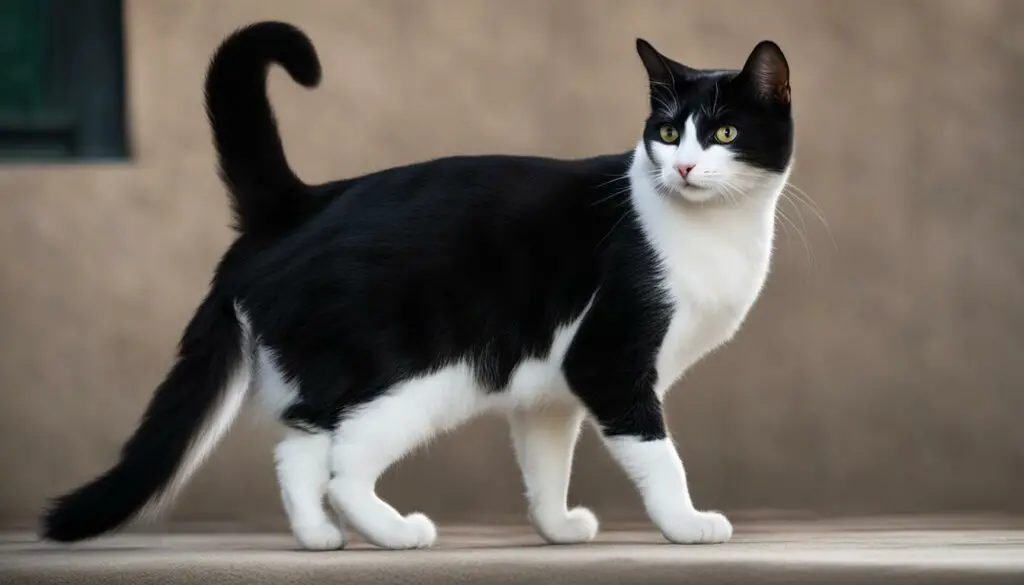
Note: Cats are complex creatures, and their behavior may vary based on individual temperament and experiences. If you have concerns about your cat’s behavior, it is advisable to consult with a veterinarian or a professional animal behaviorist for personalized guidance.
Sideways Walking in Cats: A Conclusion
Sideways walking in cats is a fascinating behavior that can be triggered by various factors. Whether it’s a defensive posture, a playful movement, an expression of excess energy, or a way to seek attention, sideways walking is a normal part of a cat’s repertoire of behaviors. By understanding the reasons behind this behavior and observing your cat’s body language, you can better communicate with your feline friend and ensure their overall well-being.
Cat behavior is complex, and sideways walking is just one of the many quirks that make our feline companions unique. By spending quality time with your cat, providing mental and physical stimulation, and creating a safe and enriched environment, you can help fulfill their needs and strengthen your bond. Remember to be attentive to any changes in behavior that may indicate underlying health issues and consult with a veterinarian if necessary.
Overall, sideways walking in cats is a normal behavior that should not be a cause for concern. Embrace your cat’s individual quirks and behaviors, and enjoy the special connection you share. Cats are mysterious creatures, and by unraveling the secrets of their behaviors, we can deepen our understanding and create a harmonious cat-human relationship.
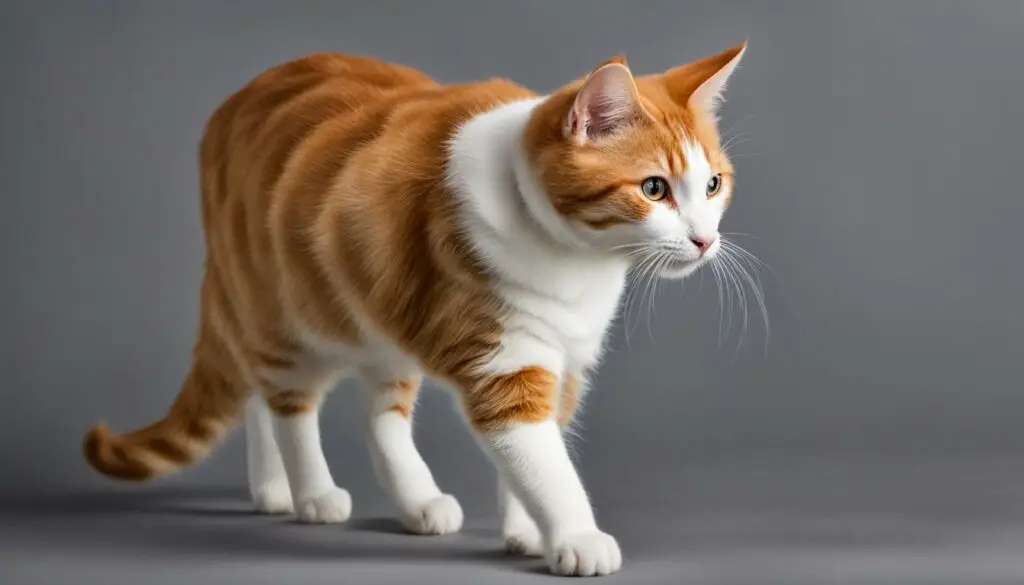
Table: Behaviors Associated with Sideways Walking in Cats
| Behavior | Possible Reasons |
|---|---|
| Defensive posture | Feeling threatened or afraid |
| Playful behavior | Expressing energy and engaging in play |
| Expression of excess energy | Releasing pent-up energy through zoomies |
| Attention-seeking behavior | Seeking interaction and playtime |
Understanding these behaviors and their underlying reasons can help you better interpret your cat’s body language and strengthen your bond. Remember to observe and listen to your cat, and embrace their unique quirks and behaviors.
Deciphering Cat Body Language: Ears and Eyes
Cats have a language of their own, and understanding their body language is key to interpreting their emotions and intentions. While sideways walking is one aspect of their behavior, their ears and eyes also provide important cues. By paying attention to the position of their ears and the expressions in their eyes, you can gain valuable insights into your cat’s mood.
Ears Position:
When a cat holds its ears forward, it is a sign of curiosity and attentiveness. It indicates that the cat is interested in its surroundings and is open to interaction. On the other hand, flattened or pinned-back ears signal aggression or fear. If your cat’s ears are in this position, it’s best to give them space and avoid any sudden movements.
Eye Expressions:
Cats’ eyes can also reveal a lot about their emotional state. Dilated pupils often indicate excitement or fear, while narrowed pupils can indicate annoyance. When your cat’s eyes are relaxed and half-closed, it signifies comfort and contentment. It’s important to note that the size of a cat’s pupils can change depending on the lighting conditions, so it’s essential to consider the overall context and other body language cues.
By understanding these subtle signals in your cat’s ears and eyes, you can deepen your communication and strengthen your bond. Observing their body language as a whole will help you respond to their needs and provide appropriate care.
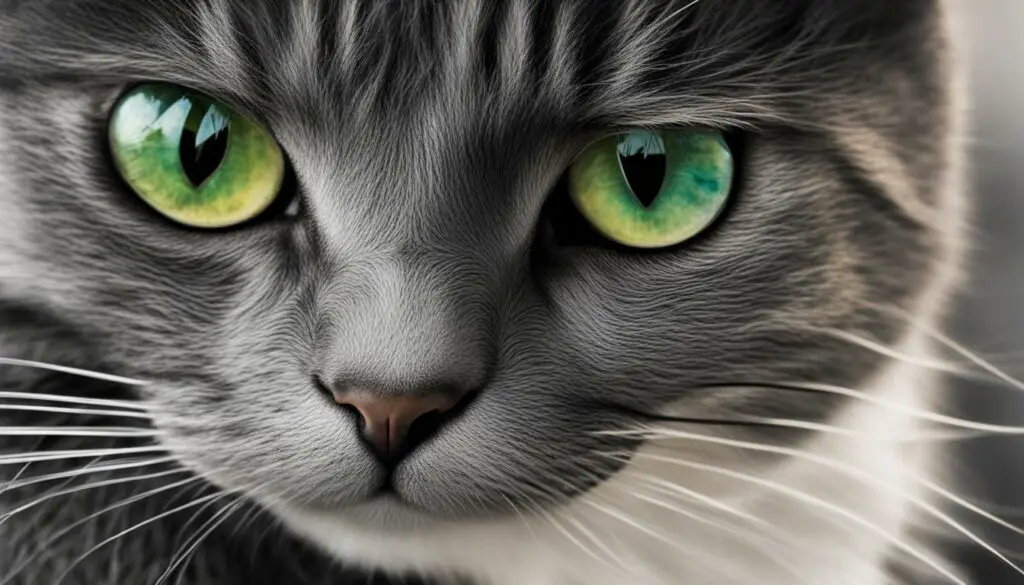
Understanding the Body Language of Your Cat
When it comes to understanding our feline friends, their body language speaks volumes. By observing their posture, movements, and gestures, we can decipher their emotions and needs. This deep understanding of cat nonverbal communication allows us to establish a stronger bond and provide the care they require.
Cat body language encompasses a wide range of signals and behaviors. For instance, when a cat approaches and rubs against you, it’s not just a display of affection but also a way of marking their territory. It’s their unique way of saying, “You belong to me!” Additionally, a cat’s tail position can reveal much about their mood. A gently swishing tail indicates curiosity, while an upright, bushy tail may indicate excitement or aggression.
Quote: “By observing their body language, we can decipher their emotions and needs.”
Another key element of cat body language is their ear positions. When a cat’s ears are held forward, they are likely curious and interested in their surroundings. On the other hand, flattened or backward-facing ears can indicate aggression or fear. It’s essential to pay attention to these subtle cues to better understand what our cats are trying to communicate.
The Importance of Understanding Cat Gestures
In addition to postures and expressions, cats also communicate through gestures. One common gesture is the slow blink. When a cat looks at you and slowly closes its eyes, it’s a sign of trust and contentment. Returning the slow blink can strengthen the bond between you and your furry friend.
Understanding cat body language allows us to meet their needs more effectively. For example, if a cat arches its back and rubs against your legs, it’s a clear sign that they are seeking attention and affection. Engaging in playtime, providing mental stimulation, and creating a safe environment that allows for exploration are essential for their overall well-being.
| Body Language | Meaning |
|---|---|
| Tail held high, gently swishing | Curiosity |
| Puffed-up tail, arched back | Aggression or fear |
| Slow blink | Trust and contentment |
| Rubbing against legs | Seeking attention |
By observing and interpreting our cats’ body language, we can better understand their emotions, needs, and desires. This knowledge enables us to provide the care, love, and attention they deserve, strengthening the bond between us. So, let’s keep a watchful eye on our furry companions and embark on a fascinating journey into the world of cat nonverbal communication.

Conclusion: Bridging the Communication Gap with Your Cat
Understanding your cat’s behavior and communicating effectively are essential for building a strong bond and fostering a harmonious cat-human relationship. By deciphering your cat’s body language and learning their unique form of communication, you can create a deeper understanding of their needs and emotions.
Observing your cat’s overall posture, movements, and vocalizations can provide valuable insights into their mood and intentions. Whether it’s decoding their ear positions, eye expressions, or deciphering their subtle gestures, each interaction is an opportunity to enhance your connection with your feline companion.
Spending quality time together, engaging in interactive play, and providing mental and physical stimulation are vital for fulfilling your cat’s natural instincts and ensuring their overall well-being. Remember to observe and listen to your cat, as they have their own language, and by actively participating in their world, you strengthen the cat-human bond.
By bridging the communication gap with your cat, you can create a loving and trusting relationship based on mutual understanding and respect. So, embrace the subtle cues, engage in their world, and let the language of cats enrich your life.
FAQ
Why do cats walk sideways?
Cats may walk sideways for various reasons, including feeling threatened, expressing playfulness, releasing excess energy, seeking attention, or as a defensive posture.
What are the signs of cat aggression?
Signs of cat aggression can include walking sideways, puffing the tail and fur, showing fangs and claws, arching the back, meowing or growling, and hissing at the opponent.
How can I prevent cat conflicts in a multi-cat household?
Understanding the triggers for cat aggression and providing a stimulating environment, quality playtime, and mental stimulation can help prevent conflicts in multi-cat households.
How can I fulfill my cat’s playtime needs?
Engaging in interactive play sessions with your cat, providing toys and mental stimulation, and spending quality time together can fulfill your cat’s playtime needs.
Is sideways walking in cats normal?
Yes, sideways walking in cats is a natural and normal behavior, especially in kittens and during bursts of high energy called “zoomies.”
How can I reduce cat aggression during the mating season?
Neutering male cats can help reduce territorial behavior and prevent unnecessary conflicts and aggression during the mating season.
What should I do if my cat is engaging in destructive behavior?
Spending quality time with your cat, providing mental stimulation, and engaging in interactive play can help curb destructive behaviors and strengthen the bond between you and your cat.
Why do kittens engage in sideways walking more often?
Kittens have higher energy levels and engage in more play behavior, including sideways walking, as part of their developing motor skills and exploration of their environment.
What does a puffed-up tail in cats indicate?
A puffed-up tail, known as piloerection, is an involuntary response to fear or aggression and serves to make the cat appear larger and more intimidating.
Why do cats arch their backs when walking sideways?
Arching the back when walking sideways is a common defensive posture in cats, allowing them to appear larger and more threatening while also displaying their sharp claws.
How can I improve communication with my cat?
By familiarizing yourself with your cat’s body language, vocalizations, and overall behavior, you can better meet their needs, strengthen your bond, and understand their unique language of communication.

